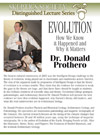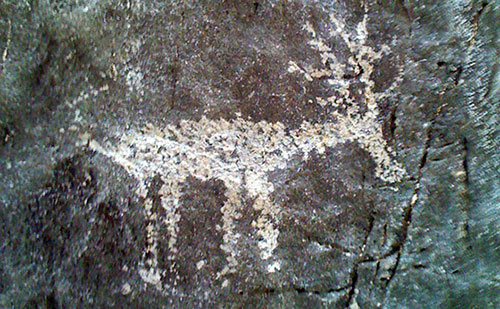In this week’s eSkeptic:

Introducing Mystery Photos
Today Michael Shermer is introducing a new feature for fun and edification that he is calling the Mystery Photo. From his own personal archives of photographs taken on his various travels, we will post a “mystery” photo to test your visual memory and/or research skills. Each Wednesday in eSkeptic, we will post a mystery photograph. Post your guesses/answers in the comments section at the bottom of eSkeptic. We will reveal the answer to this week’s Mystery Photo in next week’s eSkeptic.

A Bestiary of Creatures
Author Christopher Dell has collected an astonishing array of art from around the world depicting many obscure and mysterious creatures in his new book Monsters: A Bestiary of Devils, Demons, Vampires, Werewolves, and Other Magical Creatures.
Christopher Dell joins the MonsterTalk crew to discuss why humans are so fascinated by these bizarre entities.
About this week’s feature article
On November 4, 2005, the first ever Evolution-Intelligent Design trial of the 21st century drew to a close in Federal court in Harrisburg, Pennsylvania: Kitzmiller et al v. Dover Area School District. On December 20th, 2005, a judgement was made against the teaching of Intelligent Design. (We reported on that important decision in eSkeptic that day.) In this week’s eSkeptic, two days after the fifth anniversary of that judgment, Andrew Williams discusses some of the details from the trial as well as the current state of affairs in the ongoing creationism-evolution debate.
Andrew Zak Williams is a barrister based in England. He is also a columnist at www.secularnewsdaily.com and has articles published in the January 2011 editions of The Humanist and American Atheist.

Panda image from the cover Of Pandas and People. The Dover school board promoted the ID textbook, which led to its decision to amend the science curriculum.
The Trial of the (New) Century
Dover and the 5th Anniversary of Kitzmiller v. Dover Area School District
by Andrew Zak Williams
This year, 20th December marked the fifth anniversary of the judgment in the first major, no holds barred courtroom battle between Evolution and the new species of creationism known as Intelligent Design (ID). The question before the court was whether Intelligent Design was a credible scientific theory. If so, the school board of a small town in Pennsylvania would be able to argue that it had acted lawfully when it amended its science curriculum to include the reading to students of a description of ID, along with recommended readings promoting this new form of creationism. If ID was just a religious belief, however, discussing it in a science classroom would be a violation of the Establishment Clause of the First Amendment, which aims to provide separation of church and state.
ID’s “big tent” had already become a public relations triumph, attracting the support of bible-thumping Christians, a sprinkling of academics, and millions in between. In fact, during the weeks before the case came to court, President George W. Bush had stated his belief that students should be taught both sides of the controversy, and the Pope was reported to be reconsidering the Vatican’s acceptance of evolution. Meanwhile ID was being featured prominently in the likes of such venues as the New York Times, the American Spectator, and on late night TV debates.
The trial would be called Kitzmiller v. Dover Area School District. And like a boxing promoter anticipating the big fight, leading ID proponent William Dembski wrote on his website in May 2005:
I therefore await the day when the hearings … involve subpoenas that compel evolutionists to be deposed and interrogated at length on their views … What I propose, then, is a strategy for interrogating the Darwinists to, as it were, squeeze the truth out of them.
The article, which is still available on the ID-supporting Uncommon Descent website, is accompanied by a picture of a Darwin doll with its head in a vise.
This kind of aggression from parts of the Christian community is explicable. For them, Kitzmiller was concerned with more than a science curriculum. It was a battle between worldviews: theism and godless materialism. As Daniel Dennett previously noted, “The theory of evolution diminishes the best reason anyone has ever suggested for believing in a divine creator.”
There could be no doubt: if the claim brought by Ms. Kitzmiller and her fellow disaffected parents were to fail, other school boards would soon follow Dover’s lead and introduce ID into their science classes nationwide.
Is ID Science?
Evolution refers to the idea that (1) species change through time and that (2) they are all descended from one or more common ancestors. It was Darwin who explained that (3) the engine that drives evolution is natural selection. At trial, the Dover board called biologist Michael Behe, a leading ID scientist, as its star witness. After all, it is his theory of Irreducible Complexity that underpins much of the ID movement. His evidence made clear that ID proponents don’t necessarily reject the first two prongs of evolution. But they deny the third one. According to IDers, natural selection is incapable of driving evolution on the scale required to account for the diversity of life on the planet. Cue the Intelligent Designer.
Leaving aside its religious implications, is ID even scientific? The plaintiffs’ expert witness, biologist and believer Kenneth Miller, said no. Science is the systematic attempt to “provide natural explanations for natural phenomena.” Crucially, ID cannot be science because it relies upon a supernatural being.
Behe and microbiologist Scott Minnich argued for a different definition of science that allows for the introduction of the supernatural. For them, ID is science “because it relies completely on the physical, observable, empirical facts about nature plus logical inferences.” According to Behe, the sub-cellular world appears to be designed, and so it is scientific to conclude that it must have been designed unless there is a compelling reason to believe otherwise. Unfortunately for him, Behe was forced to admit that his definition was so loose that it embraced even astrology.
But there was another reason why the school board was always going to be on the back foot when it came to proving that ID was science. It had been the fall-out from the Dover school board’s decision to promote the ID textbook, Of Pandas and People, which had led to its decision to amend the science curriculum.
The plaintiffs called philosopher Barbara Forrest to describe the history of the book under its various titles. The first two editions and the first draft of the third edition had explicitly taught creationism. But the second draft of the third edition eradicated the language of creationism and replaced it with ID-speak. What had happened between the two drafts to bring about this change? Forrest explained that the supervening event was the 1987 case Edwards v. Aguillard. In that case the Supreme Court held that teaching creation science violated the Establishment Clause because it involved teaching a religious belief rather than science. Although all subsequent editions used revised labels, such as replacing the word “creation” with “design,” at heart this was still a creationist text. Humorously, in the cut-and-paste process they failed to select the whole word before pasting in the new term “design proponent,” resulting in the hybrid “cdesign proponentists.”
Irreducible Complexity
What is Behe’s theory upon which the scientific credibility of ID rests? Behe claims that if you analyze the blood-clotting system, the immune system and the bacterial flagellum, you’ll see that they are “irreducibly complex”. To explain what this means, he says that if these had evolved by natural selection, there must have been many intermediate forms between their simple earliest states and their present highly complex ones. But Behe claimed that this couldn’t have happened through a step-wise gradual system such as natural selection because each of the intermediate forms would have been useless and thus eliminated by natural selection.
When Behe first published his theory it was not subjected to the process of peer review that scientific journals demand. Instead, he laid out his thoughts in the 1996 book Darwin’s Black Box, which sold largely to a religious audience desperate to embrace his conclusions. What’s more, rather than providing compelling evidence, Behe set out the reasons for his theory and left it to others to disprove it.
Even though it is exceptionally difficult to prove the evolutionary history of these types of biological systems, evolutionists rose to the challenge. In the case of the flagellum, evolutionary biologists have relied on a concept known as exaptation, or an ex-adaptation. This refers to the evolution of a system that evolved for one function but later evolved into a different use. In his courtroom testimony, Kenneth Miller explained that some bacteria possess a kind of syringe known as a Type III Secretory System (“TTSS”). The TTSS shares many protein parts with the flagellum but has fewer of them. And so the TTSS could have been naturally selected for its effectiveness at secreting things from inside to outside the cell before evolving into what eventually became a device for propulsion called the flagellum. Crucially, this demonstrated that if you remove some of the components of the flagellum, the result could be a working organic system, which is a fatal blow to the theory of irreducible complexity.
The blood-clotting system fared no better under the withering cross-examination by the plaintiffs’ attorneys. Behe’s book had based much of its blood-clotting discussion on work carried out by Richard Doolittle. It was therefore an especial blow to Behe that in 2003 Doolittle himself published a paper that demonstrated that pufferfish lack at least three of the 26 factors found in the blood-clotting system, but crucially they possess what is still a workable blood-clotting system. This put to the lie Behe’s claim that the system is irreducibly complex. What’s more, there’s no need to rely on the exaptation argument above.
As for the immune system, Behe stated, “The scientific literature has no detailed, testable answers to the question of how the immune system could have arisen by random mutation and natural selection.” In one of the few visually dramatic points of the trial, the plaintiffs’ lawyer piled a tower of over seventy articles and books on the witness stand that he confidently proclaimed provided that very explanation. Peering from behind the stack, Behe admitted that he hadn’t read it all but nonetheless insisted that it just wasn’t “good enough.”
20th December 2005 and Beyond
At 10.30 on a crisp morning on Tuesday, 20th December 2005, Judge John Jones III handed down his judgment: all 139 pages of it. He was a religious man who was appointed to the job by George W. Bush. Even so, his ruling was a damning indictment of ID.
Judge Jones explained that he couldn’t avoid “the inescapable conclusion that ID is an interesting theological argument, but that it is not science. … The overwhelming evidence at trial established that ID is a religious view, a mere re-labeling of creationism, and not a scientific theory.” Jones also noted that ID’s central argument of irreducible complexity was nothing new. After all, it employed the same flawed and illogical contrivances that doomed creation science in the 1980s. And ID’s failure to produce peer-reviewed publications was the final nail in the coffin of any scientific pretensions. In all, Jones concluded, it was “abundantly clear that the Board’s ID Policy violates the Establishment Clause,” as does teaching ID in science class generally.
The ruling has the force of law in only one of Pennsylvania’s three federal judicial districts. But Judge Jones’ decision serves as a warning to any school district thinking of instituting a policy similar to Dover. Only last November, 2010, Education Week reported that in several U.S. states school officials still feel emboldened by the ruling. The result has been a range of new curriculum materials, more teacher training, and pro-evolution activism by teachers.
The Dover ruling clearly polarized opinion. For some it was the latest step in a Darwinian conspiracy to eradicate religion, and with it moral certainty. But only a year before the trial, ID theorist and Discovery fellow Paul Nelson admitted:
Easily the biggest challenge facing the ID community is to develop a full-fledged theory of biological design. … Right now, we’ve got a bag of powerful intuitions and a handful of notions such as irreducible complexity and specified complexity, but as yet, no general theory of biological design.
And in 2006, Phillip Johnson, the figurehead of ID, gave an interview to Berkeley Science Review in which he conceded: “No [ID] product is ready for competition in the educational world.” In the light of these admissions, the kind of vitriol to which Judge Jones has been subjected is a stain on the fading honor of the ID movement.
Of course, the fact that ID isn’t science doesn’t necessarily mean that it’s wrong. Jones’ judgment was a little surprising in this respect. He justified his decision that ID isn’t science, in part, by referring to the fact that it had failed to be accepted by the scientific community and that it had been refuted by scientists. But curiously, he didn’t go one step further and rely on those facts to conclude that the theory wasn’t true. On the contrary, for legal reasons having to do with the restriction of the court to narrowly rule on the matter at hand, he expressly stated that the court was taking no position on that question.
Teach the Controversy
The Discovery Institute, ID’s flashing beacon, is clear in its stance: its theory exists and so it’s only fair for schoolchildren to be taught both sides of the argument. And if ID can’t be taught, children should at least be taught the controversy. The fact that ID is religious and unscientific doesn’t come into it: nor does the fact that in scientific terms there’s no controversy to teach.
The ID movement may have been born out of a desire to replace moral relativism with religious absolutes. But conversely, when it comes to education, it seeks to remove scientific absolutes and to replace them with a relativist approach in which proven science is taught alongside any theory which garners enough publicity to demand to be heard.
Frustratingly for the scientific community, most of the American public agrees with the “Teach the Controversy” slogan. With its implied appeal to fair play, it’s an inspired piece of marketing. But Judge Jones wasn’t impressed. To him, the motto “is at best disingenuous, and at worst a canard. The goal of the ID [movement] is not to encourage critical thought, but to foment a revolution which would supplant evolutionary theory with ID.”
In the realms of ID science, the movement marches on almost as though Kitzmiller didn’t happen, with the likes of Michael Behe, Stephen C. Meyer, William Dembski, and Steve Fuller penning recent books which have attracted media attention. And in 2008 an independent film entitled Expelled: No Intelligence Allowed was released, in which it was alleged that mainstream science suppresses academics who support ID. (Read Expelled Exposed on skeptic.com) The film has been used in private screenings for legislators as part of the Discovery Institute’s campaign to introduce Academic Freedom bills into state legislatures. Discovery’s website even provides a boilerplate for those looking to draft this kind of legislation. In the main, the bills have been defeated, although Governor Bobby Jindal signed one into law in Louisiana in 2008.
Nevertheless, Kitzmiller came as a well-deserved boon to pro-evolution teachers and scientists. Five years on, however, it is clear that in the battle between different worldviews, there’s no truce in sight as creationism continues to evolve.
Skeptical perspectives on evolution
-
 Browse our evolution/creationism books
Browse our evolution/creationism books
($5 and up) by various authors
-
 Browse our evolution/creationism lectures
Browse our evolution/creationism lectures
(CD $15.95 DVD $23.95) by various authors

NEW ON SKEPTICBLOG.ORG
Fossil Hunting Without Creationists
This past weekend, December 17–19, 2010, I joined paleontologists Donald Prothero from Occidental College and John Long from the Natural History Museum of Los Angeles County on a fossil hunting, rock hopping, geology viewing, petroglyph scanning excursion through the Mojave Desert between Los Angeles and Las Vegas. Through the entire trip I kept thinking “I wish the creationists and Intelligent Design theorists would try their hand at some actual field work because then they would see (and hear and smell and especially touch) what nature is really like and what the history of life reveals in the rocks…












